A Novel Mathematical Approach to Model Multi-Agent-Based Main Grid and Microgrid Networks for Complete System Analysis
Abstract
:1. Introduction
2. Preliminaries and Basic Definitions
2.1. Power Systems
2.2. Algebraic Graph Theortic Model of Power Network
2.3. Power Microgrid
- The connectivity of the microgrid with the power network is at MV or LV level;
- The point of connectivity of the microgrid to the remaining power network is the point of common coupling (PCC), i.e., single point of connection;
- A microgrid comprises power generation units, energy storage elements, transmission and distribution lines, protection components, management systems, and loads;
- The capacity of power generation and storage in a microgrid must be enough to meet the demand requirements for some time period;
- Microgrid operations are either grid-connected or islanded and controller design operational modes vary accordingly.
3. Graph Theoretic Analysis and Control of Power Systems
Graph Theoretic Analysis and Modeling of Power System
4. Inverter Interface Microgrid Components and Control Strategies Review
4.1. Modeling of Microgrid
4.2. Modeling of Power Electronic Inverter
4.3. Modeling of Power Transmission Lines
4.4. Modeling of Microgrid Protection System
4.5. Microgrid Model
Modeling of Power Microgrid in Island Mode
4.6. Control Strategies for the Power Microgrid: Review
5. Challenges and Opportunities in the Power Systems’ Stability and Control
5.1. Challenges in Energy Storage Units
5.2. Challenges in Transmission and Distribution Systems
5.3. Challenges in Distributed Control
6. Conclusions
Author Contributions
Funding
Institutional Review Board Statement
Informed Consent Statement
Data Availability Statement
Conflicts of Interest
References
- Tamimi, B.; Canizares, C.; Bhattacharya, K. System Stability Impact of Large-Scale and Distributed Solar Photovoltaic Generation: The Case of Ontario, Canada. IEEE Trans. Sustain. Energy 2013, 4, 680–688. [Google Scholar] [CrossRef]
- Serag ElDin, A.M.A.M.; El-Mahgary, Y.; Ali, A.H.H.; Khairy, A. Comparing socioeconomic & environmental impacts of building 2GW PV power plant in both sides of the Medeterranian. In Proceedings of the 2013 International Renewable and Sustainable Energy Conference (IRSEC), Quarzazate, Morocco, 7–9 March 2013; pp. 331–336. [Google Scholar]
- Blaabjerg, F.; Teodorescu, R.; Liserre, M.; Timbus, A.V. Overview of Control and Grid Synchronization for Distributed Power Generation Systems. IEEE Trans. Ind. Electron. 2006, 53, 1398–1409. [Google Scholar] [CrossRef] [Green Version]
- Cao, Y.; Wang, X.; Li, Y.J.; Tan, Y.; Xing, J.; Fan, R. A comprehensive study on low-carbon impact of distributed generations on regional power grids: A case of Jiangxi provincial power grid in China. Renew. Sustain. Energy Rev. 2016, 53, 766–778. [Google Scholar] [CrossRef]
- Natesan, C.; Ajithan, S.K.; Palani, P.; Kandhasamy, P. Survey on Microgrid: Power Quality Improvement Techniques. ISRN Renew. Energy 2014, 2014, 342019. [Google Scholar] [CrossRef]
- Sen, S.; Kumar, V. Microgrid control: A comprehensive survey. Annu. Rev. Control 2018, 45, 118–151. [Google Scholar] [CrossRef]
- Nikos, D. Hatziargyriou Microgrids: Architectures and Control; Hatziargyriou, N., Ed.; Wiley-IEEE Press: Athens, Greece, 2013; ISBN 978-1-118-72064-6. [Google Scholar]
- Dorfler, F.; Bolognani, S.; Simpson-Porco, J.W.; Grammatico, S. Distributed Control and Optimization for Autonomous Power Grids. In Proceedings of the 2019 18th European Control Conference (ECC), Naples, Italy, 25–28 June 2019; pp. 2436–2453. [Google Scholar]
- Invernizzi, G.; Vielmini, G. Challenges in Microgrid Control Systems Design. An application case. In Proceedings of the 2018 AEIT International Annual Conference, Bari, Italy, 3–5 October 2018; pp. 1–6. [Google Scholar]
- Nejabatkhah, F.; Li, Y.W.; Tian, H. Power Quality Control of Smart Hybrid AC/DC Microgrids: An Overview. IEEE Access 2019, 7, 52295–52318. [Google Scholar] [CrossRef]
- Mahmoud, M.S. Microgrid Control Problems and Related Issues. In Microgrid; Elsevier: Dhahran, Saudi Arabia, 2017; pp. 1–42. [Google Scholar]
- Zeng, Z.; Yang, H.; Zhao, R. Study on small signal stability of microgrids: A review and a new approach. Renew. Sustain. Energy Rev. 2011, 15, 4818–4828. [Google Scholar] [CrossRef]
- Majumder, R. Some Aspects of Stability in Microgrids. IEEE Trans. Power Syst. 2013, 28, 3243–3252. [Google Scholar] [CrossRef]
- Elrayyah, A.; Sozer, Y.; Elbuluk, M. Simplified modeling procedure for inverter-based islanded microgrid. In Proceedings of the 2012 IEEE Energytech, Cleveland, OH, USA, 29–31 May 2012; pp. 1–6. [Google Scholar]
- Patowary, M.; Panda, G.; Deka, B.C. Reliability Modeling of Microgrid System Using Hybrid Methods in Hot Standby Mode. IEEE Syst. J. 2019, 13, 3111–3119. [Google Scholar] [CrossRef]
- Kundur, P.; Balu, N.J.; Lauby Mark, G. Power System Stability and Control; McGraw-Hill: New York, NY, USA, 1994. [Google Scholar]
- Bahrami, S.; Mohammadi, A. Smart Microgrids, Bahrami, S., Mohammadi, A., Eds.; Springer International Publishing: Cham, Switzerland, 2019; ISBN 978-3-030-02655-4. [Google Scholar]
- Vittal, V.; McCalley, J.D.; Anderson, P.M.; Fouad, A.A. Power System Control and Stability, 3rd ed.; Wiley-IEEE Press: Hoboken, NJ, USA, 2019; ISBN 978-1-119-43371-2. [Google Scholar]
- Ishizaki, T.; Chakrabortty, A.; Imura, J.-I. Graph-Theoretic Analysis of Power Systems. Proc. IEEE 2018, 106, 931–952. [Google Scholar] [CrossRef]
- Godsil, C.; Royle, G. Algebraic Graph Theory (Graduate Texts in Mathematics); Springer: New York, NY, USA, 2001; Volume 207, ISBN 978-0-387-95220-8. [Google Scholar]
- Zamora, R.; Srivastava, A.K. Controls for microgrids with storage: Review, challenges, and research needs. Renew. Sustain. Energy Rev. 2010, 14, 2009–2018. [Google Scholar] [CrossRef]
- Hasan, N.S.; Hassan, M.Y.; Majid, M.S.; Rahman, H.A. Review of storage schemes for wind energy systems. Renew. Sustain. Energy Rev. 2013, 21, 237–247. [Google Scholar] [CrossRef]
- Dorfler, F.; Simpson-Porco, J.W.; Bullo, F. Electrical Networks and Algebraic Graph Theory: Models, Properties, and Applications. Proc. IEEE 2018, 106, 977–1005. [Google Scholar] [CrossRef]
- Dorfler, F.; Bullo, F. Kron Reduction of Graphs With Applications to Electrical Networks. IEEE Trans. Circuits Syst. I Regul. Pap. 2013, 60, 150–163. [Google Scholar] [CrossRef] [Green Version]
- Schiffer, J.; Ortega, R.; Astolfi, A.; Raisch, J.; Sezi, T. Conditions for stability of droop-controlled inverter-based microgrids. Automatica 2014, 50, 2457–2469. [Google Scholar] [CrossRef] [Green Version]
- Khayat, Y.; Shafiee, Q.; Heydari, R.; Naderi, M.; Dragicevic, T.; Simpson-Porco, J.W.; Dorfler, F.; Fathi, M.; Blaabjerg, F.; Guerrero, J.M.; et al. On the Secondary Control Architectures of AC Microgrids: An Overview. IEEE Trans. Power Electron. 2020, 35, 6482–6500. [Google Scholar] [CrossRef]
- Morsali, J.; Zare, K.; Tarafdar Hagh, M. Applying fractional order PID to design TCSC-based damping controller in coordination with automatic generation control of interconnected multi-source power system. Eng. Sci. Technol. Int. J. 2017, 20, 1–17. [Google Scholar] [CrossRef] [Green Version]
- Liu, Z.; Su, C.; Hoidalen, H.K.; Chen, Z. A Multiagent System-Based Protection and Control Scheme for Distribution System With Distributed-Generation Integration. IEEE Trans. Power Deliv. 2017, 32, 536–545. [Google Scholar] [CrossRef]
- Kiel, E.S.; Hovin Kjolle, G. The impact of protection system failures and weather exposure on power system reliability. In Proceedings of the 2019 IEEE International Conference on Environment and Electrical Engineering and 2019 IEEE Industrial and Commercial Power Systems Europe (EEEIC / I&CPS Europe), Genova, Italy, 10–14 June 2019; pp. 1–6. [Google Scholar]
- Hu, J.; Zhu, J.; Dorrell, D.G. Model predictive control of inverters for both islanded and grid-connected operations in renewable power generations. Iet Renew. Power Gener. 2014, 8, 240–248. [Google Scholar] [CrossRef] [Green Version]
- Hojabri, M.; Ahmad, A.Z.; Toudeshki, A. An Overview on Current Control Techniques for Grid Connected Renewable Energy Systems. Int. Proc. Comput. Sci. Inf. Technol. 2012, 56, 119. [Google Scholar]
- Rodriguez, P.; Luna, A.; Candela, I.; Mujal, R.; Teodorescu, R.; Blaabjerg, F. Multiresonant Frequency-Locked Loop for Grid Synchronization of Power Converters Under Distorted Grid Conditions. IEEE Trans. Ind. Electron. 2011, 58, 127–138. [Google Scholar] [CrossRef] [Green Version]
- Tayab, U.B.; Roslan, M.A.B.; Hwai, L.J.; Kashif, M. A review of droop control techniques for microgrid. Renew. Sustain. Energy Rev. 2017, 76, 717–727. [Google Scholar] [CrossRef]
- Arfeen, Z.A.; Khairuddin, A.B.; Larik, R.M.; Saeed, M.S. Control of distributed generation systems for microgrid applications: A techno-logical review. Int. Trans. Electr. Energy Syst. 2019, 29, e12072. [Google Scholar] [CrossRef] [Green Version]
- Yoo, H.-J.; Nguyen, T.-T.; Kim, H.-M. Consensus-Based Distributed Coordination Control of Hybrid AC/DC Microgrids. IEEE Trans. Sustain. Energy 2020, 11, 629–639. [Google Scholar] [CrossRef]
- Hossain, E.; Hossain, J.; Un-Noor, F. Utility Grid: Present Challenges and Their Potential Solutions. IEEE Access 2018, 6, 60294–60317. [Google Scholar] [CrossRef]
- Telukunta, V.; Pradhan, J.; Agrawal, A.; Singh, M.; Srivani, S.G. Protection challenges under bulk penetration of renewable energy resources in power systems: A review. CSEE J. Power Energy Syst. 2017, 3, 365–379. [Google Scholar] [CrossRef]
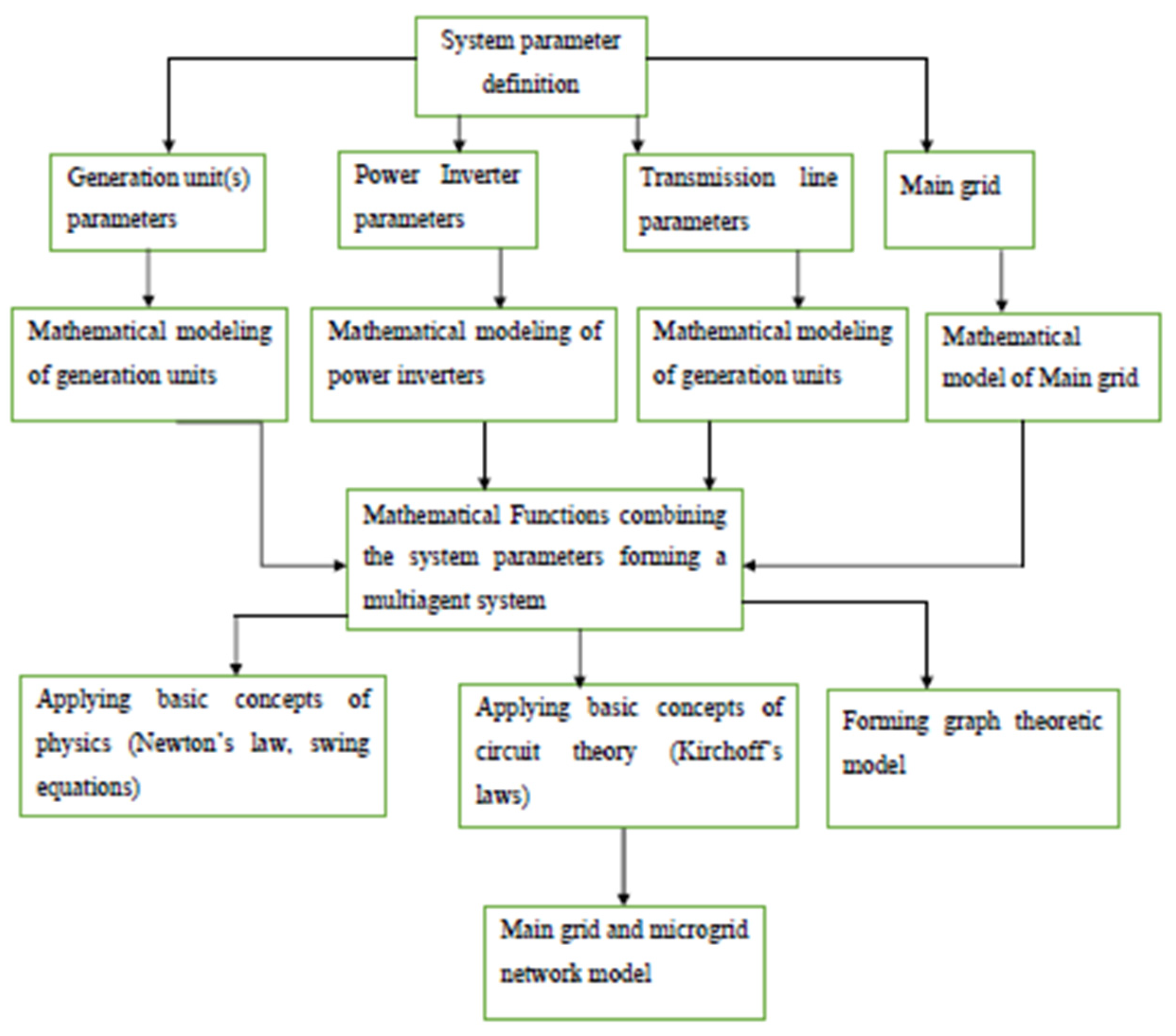
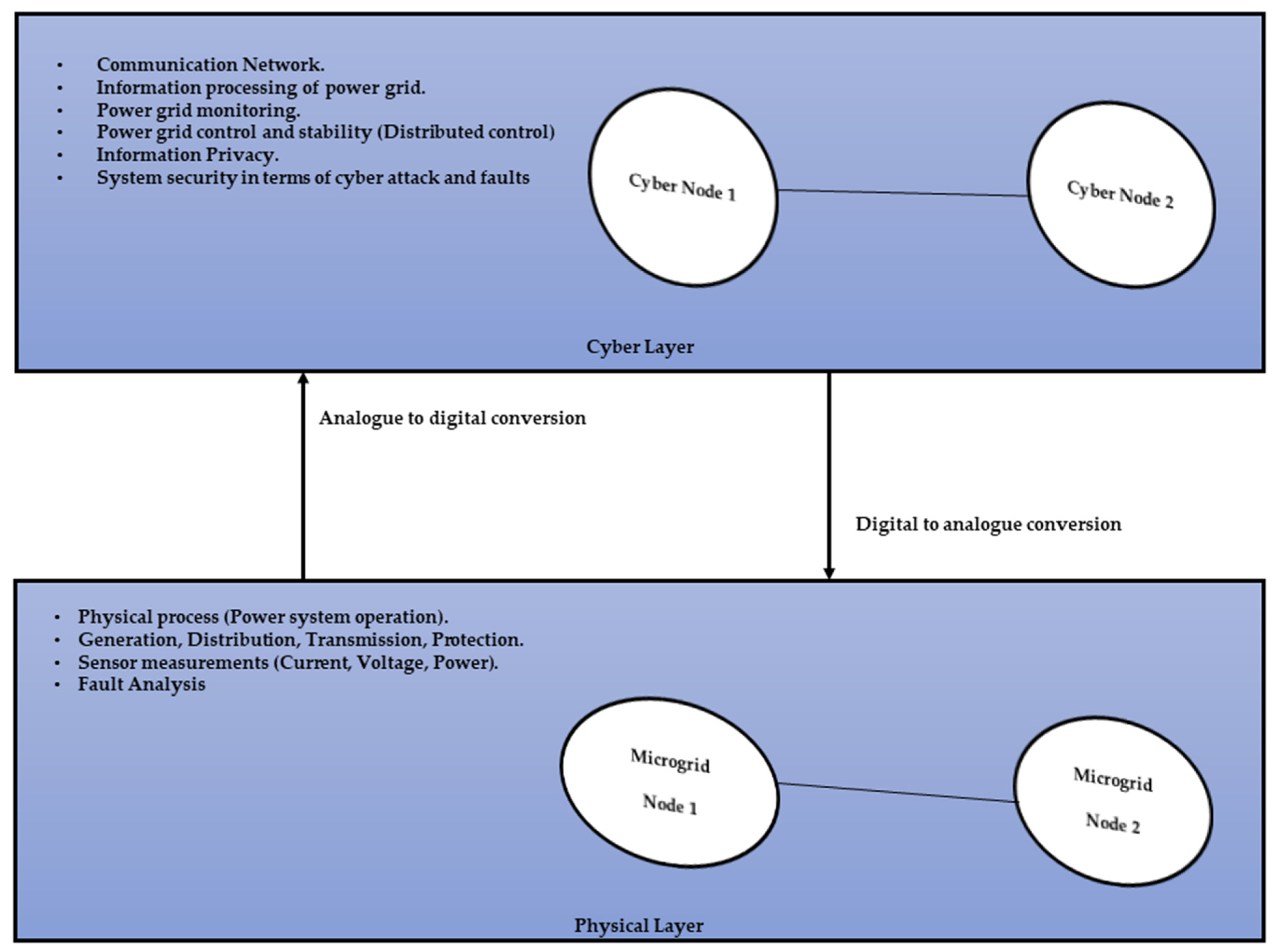


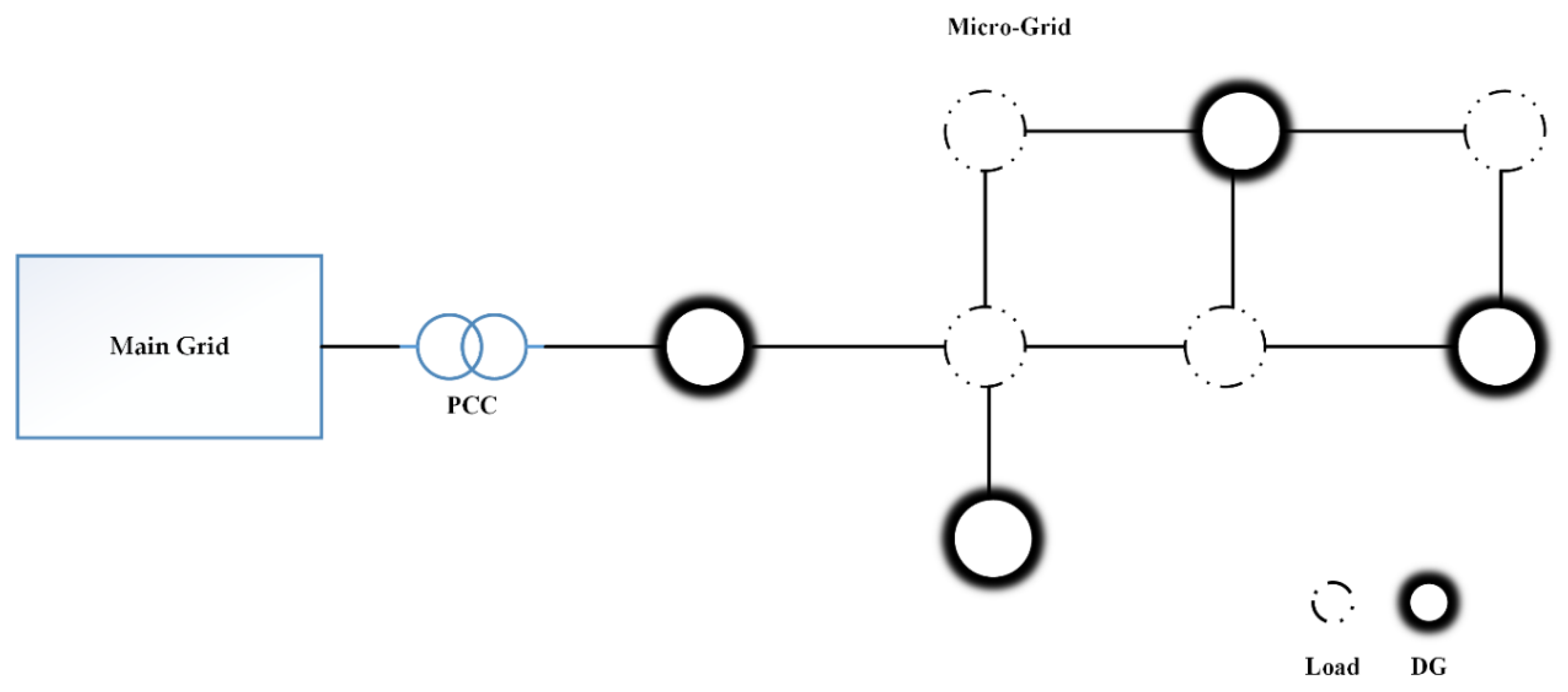
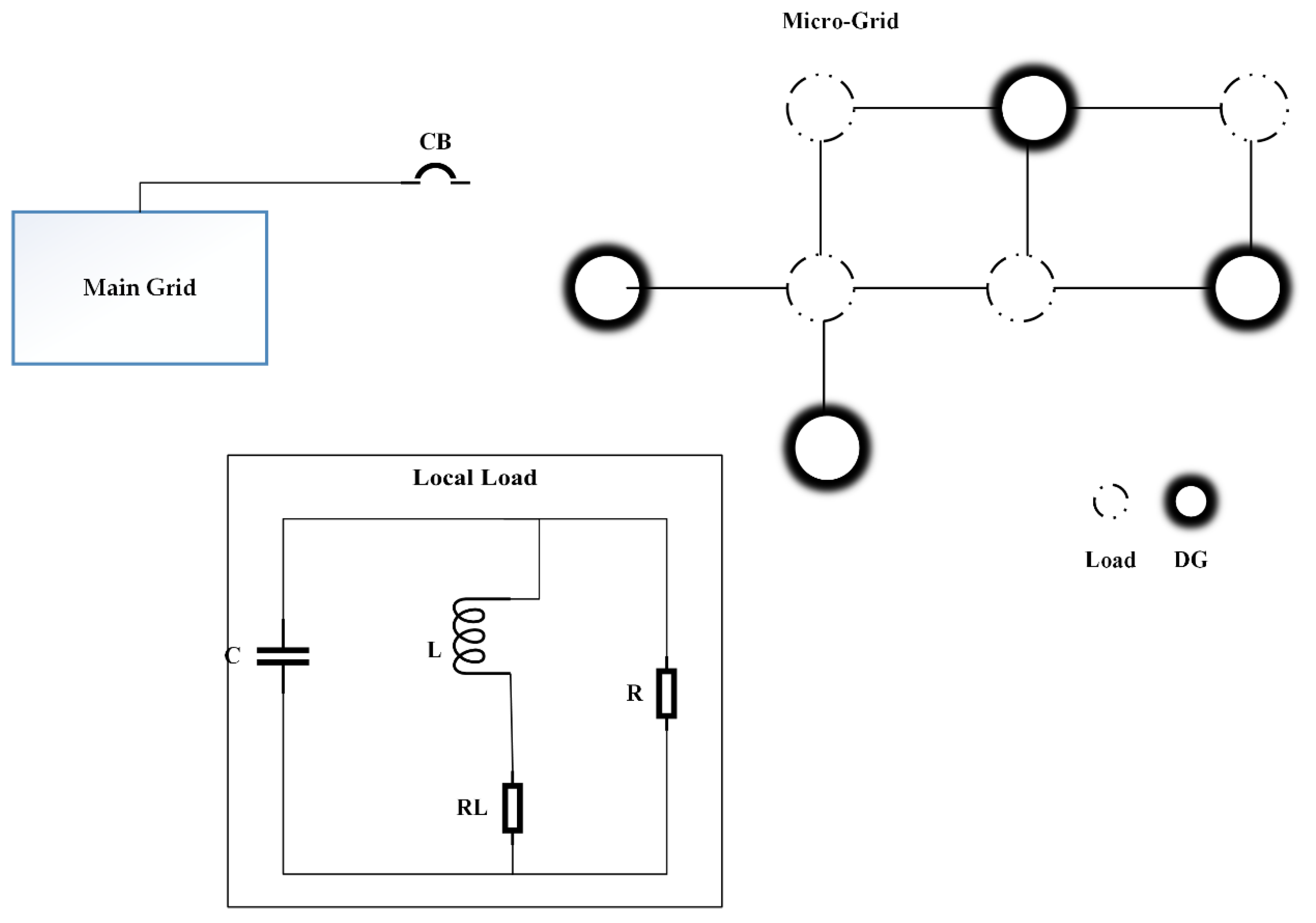


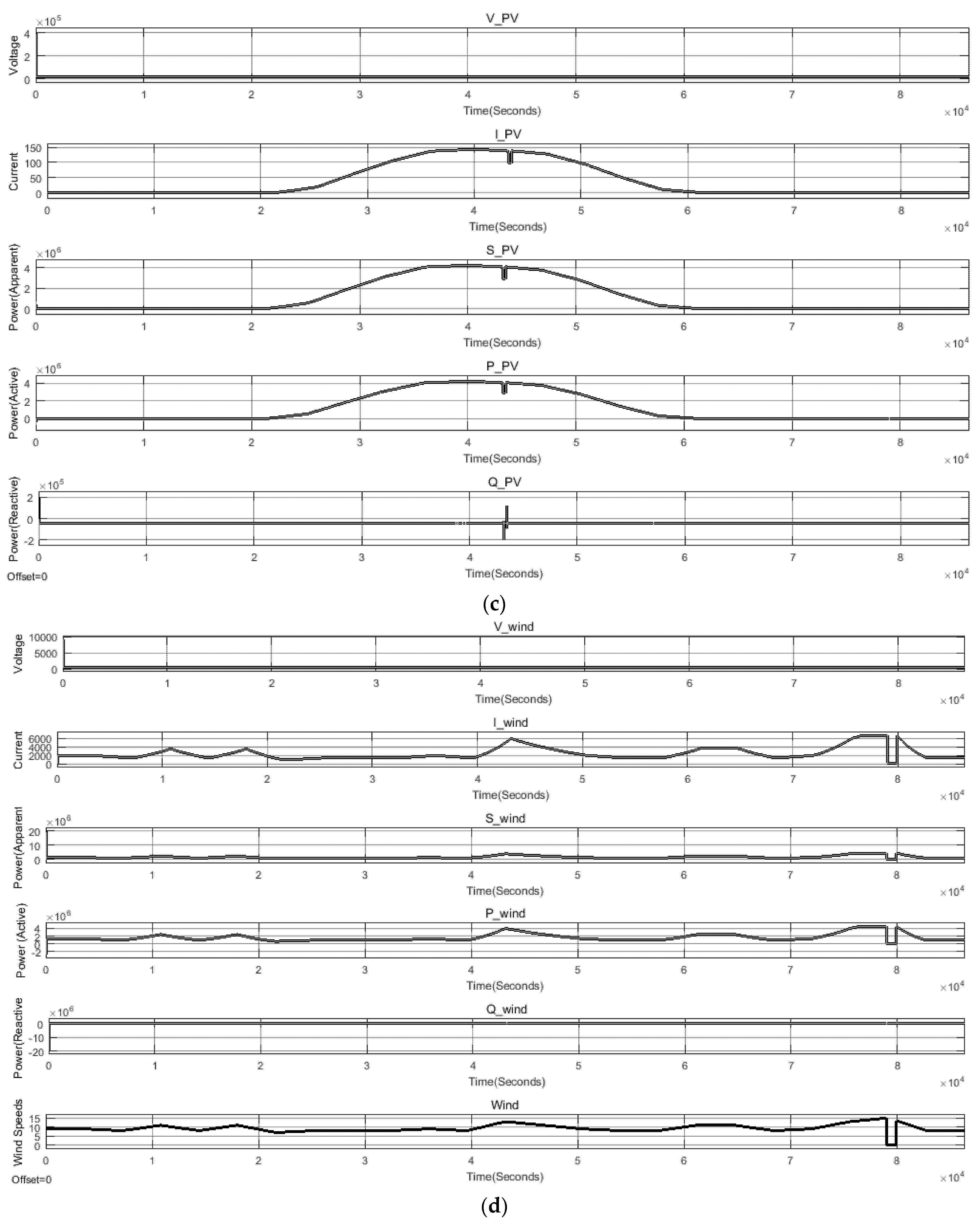

| Main Grid | ||
|---|---|---|
| Generation Unit | Capacity | Properties |
| Wind Power | 4.5 MW | 13.5 m/s nominal speed |
| Thermal | 15 MW | Diesel generator |
| Solar PV | 8 MW | 8000 area |
| Load = 10 MW | ||
| Microgrid | ||
| Generation Unit | Capacity | Properties |
| Solar PV | 8 MW | 100 area |
| Energy Storage | battery capacity (250 Ah) | Rechargeable |
| Load = 6 MW | ||
| Generation Source/Load | Base Voltage | Reference Voltage (Pu) |
|---|---|---|
| Thermal power generation | 25 kV | 1 pu |
| Wind power generation | 0.6 kV | 1 pu |
| Solar PV generation | 0.6 kV | 1 pu |
| Load | 1 kV | 1 pu |
Publisher’s Note: MDPI stays neutral with regard to jurisdictional claims in published maps and institutional affiliations. |
© 2022 by the authors. Licensee MDPI, Basel, Switzerland. This article is an open access article distributed under the terms and conditions of the Creative Commons Attribution (CC BY) license (https://creativecommons.org/licenses/by/4.0/).
Share and Cite
Hamza, A.; Rizvi, S.T.H.; Safder, M.U.; Asif, H. A Novel Mathematical Approach to Model Multi-Agent-Based Main Grid and Microgrid Networks for Complete System Analysis. Machines 2022, 10, 110. https://doi.org/10.3390/machines10020110
Hamza A, Rizvi STH, Safder MU, Asif H. A Novel Mathematical Approach to Model Multi-Agent-Based Main Grid and Microgrid Networks for Complete System Analysis. Machines. 2022; 10(2):110. https://doi.org/10.3390/machines10020110
Chicago/Turabian StyleHamza, Ameer, Syed Tahir Hussain Rizvi, Muhammad Umair Safder, and Haleema Asif. 2022. "A Novel Mathematical Approach to Model Multi-Agent-Based Main Grid and Microgrid Networks for Complete System Analysis" Machines 10, no. 2: 110. https://doi.org/10.3390/machines10020110
APA StyleHamza, A., Rizvi, S. T. H., Safder, M. U., & Asif, H. (2022). A Novel Mathematical Approach to Model Multi-Agent-Based Main Grid and Microgrid Networks for Complete System Analysis. Machines, 10(2), 110. https://doi.org/10.3390/machines10020110







